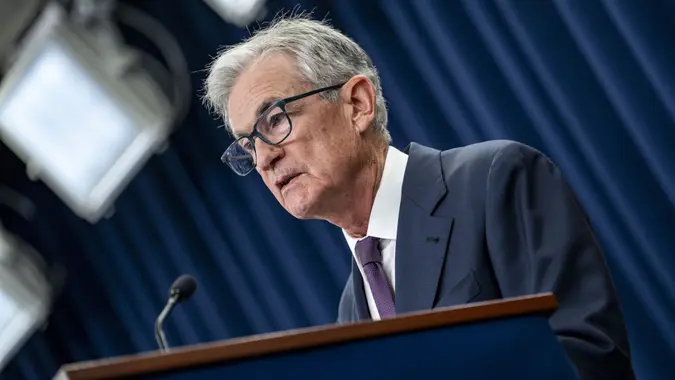3 Ways President Biden’s Policies Impact the Middle Class’ Money

Commitment to Our Readers
GOBankingRates' editorial team is committed to bringing you unbiased reviews and information. We use data-driven methodologies to evaluate financial products and services - our reviews and ratings are not influenced by advertisers. You can read more about our editorial guidelines and our products and services review methodology.

20 Years
Helping You Live Richer

Reviewed
by Experts

Trusted by
Millions of Readers
President Joe Biden is ramping up his campaign for the contentious upcoming election. He is running on a slew of promises, with the middle class and the economy as big talking points. As Biden tries to win over the public for a second term, his approval rates are slipping as of last month. “Americans’ ratings of Joe Biden’s job performance remain more negative than positive and have been largely stable over the last year: Today, 35% of Americans approve of his performance, while 62% disapprove,” according to the Pew Research Center.
In addition, “Just 10% of Americans say middle-class families have benefited a lot from Biden’s policies so far while 51% say the middle class has not benefited at all,” per a Monmouth University poll.
If Biden does serve a second term, many of his policies will affect the middle class, and GOBankingRates spoke to finance experts about their impact.
The Tax Cuts and Job Acts
In 2017, then-President Donald Trump signed the Tax Cuts and Jobs Act into law, which brought sweeping changes to the tax code by reforming individual and business taxes. However, according to the Center on Budget and Policy Priorities, a nonpartisan research and policy institute, the tax policy benefited the wealthy and didn’t deliver on economic promises.
“Households with incomes in the top 1 percent will receive an average tax cut of more than $60,000 in 2025, compared to an average tax cut of less than $500 for households in the bottom 60 percent,” CBPP’s site stated. “As a share of after-tax income, tax cuts at the top — for both households in the top 1 percent and the top 5 percent — are more than triple the total value of the tax cuts received for people with incomes in the bottom 60 percent.”
But, the middle class didn’t see a difference in their finances; per CBPP. “The Trump Administration officials claimed that their centerpiece corporate tax rate cut would ‘very conservatively’ lead to a $4,000 boost in household income,” the site reported, adding “workers who earned less than about $114,000 on average in 2016 saw ‘no change in earnings’ from the corporate tax rate cut, while top executive salaries increased sharply.”
But that could change if Biden is voted back into office.
“If elected for a second term, Joe Biden would allow most TCJA provisions to sunset,” Nicholas A. Juhle, CFA chief investment officer with Greenleaf Trust, told us. “He proposes increasing personal income tax rates to 39.6% for individuals earning more than $400K and joint filers earning more than $450K; however, he would like to extend lower TCJA rates for people earning less than $400K per year. He would also seek (requires congressional approval) to increase the corporate income tax rate to 28% from 21%.
Affordable Child Care
Earlier this year, the Biden administration announced a new rule to help make child care more affordable, but not for every middle-class family. Vice President Kamala Harris said, “Today, we are taking another important step forward by lowering the cost of child care for more than 100,000 working families that receive federal child care assistance,” per the U.S. Department of Health and Human Services.
“President Biden has proposed an affordable child care strategy targeting the middle class if he is elected to a second term,” said Mike Dion, senior manager of finance for a Fortune 100 Entertainment Company and founder of F9Finance. “Families with income under $200,000 would pay between $0 and $10 per day for child care, depending on income. It is estimated that this would impact 16 million families. This would be a boon for middle-class families as the average cost of child care is over $14,000, and this could cap it closer to $3,000 per child.”
Biden Will Impose Higher Taxes on the Wealthy, Helping the Middle Class
In addition, Biden will impose stricter policies on the wealthy.
“Other Biden policy proposals are also geared toward increasing taxes for wealthier Americans while at least maintaining the status quo for the middle class,” Juhle explained.
He continued, “For example, Biden proposes taxing long-term capital gains and dividends at ordinary income rates for individuals with taxable income above $1M. He also proposes allowing the TCJA gift and estate tax limits to sunset from $13.6M (individual)/$26.2M (joint) to $7M/$14M. This means the amount of wealth that can transfer tax-free is reduced — obviously, this only impacts wealthier Americans with estates exceeding $7M/$14M.”
For business owners, Andy Harris, STS Capital Partners, president of North American Strategies, warned to beware.
“President Biden has proposed an increase in capital gains tax from 20% to 44.6% in his federal budget for 2025, which will impact business owners who are selling their businesses,” he told us.
According to Harris, “Many will work to sell their business in 2024 to avoid the higher capital gains tax in 2025. There are implications for both buyers (using time pressure in 2024) and sellers (to avoid risk of higher capital gains if the business does not sell in 2024).”
More From GOBankingRates
 Written by
Written by  Edited by
Edited by 

























